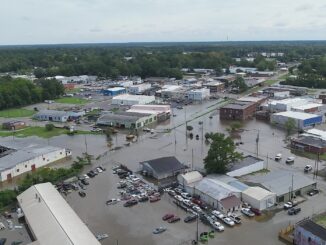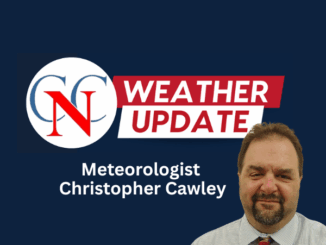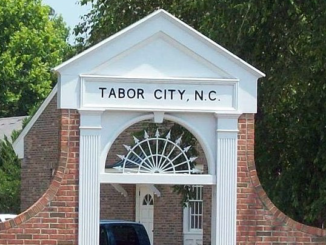
Editor’s note: following is an edited transcript of this week’s Columbus Connection. Dissenting opinions are always welcome. Email your thoughts to jeffersonweaver@columbuscountynews.com.
Municipal elections are today. We’ve had so really hot topics popping up this time around, and to call some races contested is like saying Soules Swamp rises in a hurricane.
That swamp has become the central issue in the city of Whiteville. Between the keyboard social media warriors and those politicians who never let a good crisis go to waste, there’s been a raft of misinformation leading to accusations and even a few flat-out threats. It’s amazing, honestly.

I know, firsthand, the frustration of flooding in downtown Whiteville. My office sits on an area that was still swamp about 80 years ago. The water doesn’t recognize that this is now dry land, and as such, we are flooded when there’s a major rain event. Short of restoring the swamp from Talbot Street to Frazier – which I personally think is a capital idea — there’s not much can be done.
For years, state and local officials made improvements based on standard practices of the time, as well as politics. Plus the entire landscape has changed since the old days of just digging a deeper ditch and sending storm water somewhere else. It’s not a condemnation of anyone. It’s just science. Hydrography has not changed, and will not change, no matter how much we try to change the entire landscape.
As such, we have to adapt. The mistakes of the past are not the fault of those in charge now. We have to hold local leaders accountable to fix the mistakes they inherited, but there is no fast and easy fix. Once upon time, projects that would bring millions of dollars in fines and possible jail time were handled with a political wink and a nudge. It simply doesn’t work like that anymore, whether we like it or not.
The city of Whiteville is trying and has been constantly trying to find solutions to flooding problems since that cluster storm dropped 16 inches on rain on the city a few months before the devastation of Matthew. I stood in flood water and listened to the mayor and city manager discussing what to be done, while calf-deep water flowed down Madison Street. That was, I repeat, before Matthew.
One of the things that is constantly discussed is maintenance of canals, pipes and ditches. Once upon a time, these tasks were handled by farmers and private landowners; some still do this work. For a number of years, city crews and town public works in other towns did indeed go on private property and maintain private ditches, again because things were more casual then, when there were fewer regulations, liability issues and lawsuits.
Consider this, if you will: let’s say I have an overgrown ditch on my property. It affects my entire neighborhood. Is it right for me to ask for the taxpayers to fix my ditch? If so, then every other taxpayer should have their ditches cleaned by the city as well. But who is paying for that? And what if the city says no, we won’t clean yours, although we cleaned out those upstream because of … whatever. Is that right? Of course not.
I grew up in Sampson and Harnett counties, and spent a lot of time on what is best known as the South River, although we called it the Black up there (as opposed to the larger, true Black River in Sampson and Pender counties.) The towns of Dunn and Erwin had drainage problems where the two municipalities meet, and they appealed to their state and federal elected officials for help.
Back then, the Army Corps of Engineers did things differently, and there weren’t as many concerns about water quality, pollution, erosion, etc. The Corps came in and straightened, deepened and channelized the South River for miles. It basically literally became a huge ditch. Millions of dollars were spent, and we’re talking about the 1970s, when a million buck was a million bucks.
Did it solve the flooding problems? Sure – for a little while, and mainly for the new subdivisions and shopping centers, and what was briefly the largest Walmart in the continental U.S. It also dumped billions of gallons of water into the South, sending it downstream, where it flooded communities that hadn’t flooded before, at least not since the 1800s when people moved out of the swamps. Water quality sank to unimaginable levels; there were no trees or peat to filter contaminants, and the fish and wildlife along the South died out. Famers downstream lost arable land to erosion, because the water flowed so fast. All the while, more pavement and roofs were being built, thus further increasing the stormwater runoff and further polluting the water all the way down to where the South joins the Coharies to become the real Black River.
Fifty years later, those communities are again struggling to deal with stormwater runoff and flooding, due to the real problem: pavement and roofs.
In the 1980s, the Corps underwent a change in philosophy, and the pendulum swung in the other direction. Now they go to extreme length to prevent any dredging, snagging or clearing of waterways. The Corps does not care if your business floods, as long as the wildlife and fish are protected. They have specialists whose jobs entail nothing more than ensuring local governments do not unnecessarily endanger the environment.
Gone are the days of being able to call a politician, contribute to a campaign, and get a taxpayer-funded excavator crew to clear your backyard swamp and haul the debris elsewhere.
Regardless of what the keyboard warriors promise, no local official can force the Corps of Engineers, Division of Water Quality, U.S. Fish and Wildlife Service, state and federal Departments of Transportation, Environmental Quality, or any other state and federal agency to bend to the will of a person or people. No amount of Facebook reels, rhetoric, hyperbole or threats will make that happen. A raised voice does not carry nearly the weight of a well-planed study and a grant application.
Basically, anyone who tells you that if elected they will immediately fix the drainage issues anywhere, and that those they want to defeat aren’t even trying – that candidate is a liar or else dreadfully uninformed.
Work is being done to improve things in the city of Whiteville, and has been underway for ears. Sadly, it’s slow. We have had three floods at our office at 1015 South Madison. I marked the waterlines on my desk, and you’re welcome to see them. Interestingly, although Hurricane Idalea brought less water through downtown Whiteville in 2023, it flooded more than the double-punch of the big rain event the other week, when floodwaters from Chadbourn’s greatly improved drainage system flowed through downtown.
I will repeat: we had more water in the October storm than in Hurricane Idalea, but less flooding in our office.
At the same time, had a group of local businessmen not taken it on themselves to gain permission to enter private property in Soules Swamp, contracted with an explosives expert and blown the beaver dams, the almost-tropical storm of September 2024 would have flooded us. Private individuals have far fewer restraints than local government when it comes to things like that.
While there are suddenly more experts in the field of beavers than there are beavers, tearing out dams and killing the chew-happy rodents is not a one-shot solution. Beavers are like folks who move south to our area: they recognize good real estate, and have no problems building on top of the carcasses of the last residents. Beaver control must be consistent, and balanced with other efforts. No one will ever trap out all the beavers in Soules Swamp, because there are thousands more waiting to replace the hundred or so making their home there now.
When I was still trapping, I personally took out around 350 beavers over the course of a decade in one community. Those same canals and creeks still have beavers every year.
Plus there’s the problem of dealing with debris; not every blockage in Soules Swamp or any waterway is a beaver dam. Some occur naturally due to storms, debris, trash and dying trees. Environmental regulators do not like seeing natural debris removed from waterways. Sometimes a dam is not a beaver dam, but a protected natural feature. Local governments have to deal with that aspect as well.
Then there’s the issue of money. It costs money to have employees operate equipment, move said equipment, dispose of whatever they might pick up, and/or make improvements so that next time there might not be so much to handle. Pipes to build culverts cost money. It takes money to rip up and repair streets while work is being done. It takes money to perform studies and create plans so the project is done properly. As the Bible says, who sets out to build a tower without measuring and figuring what it will take, lest he not be able to complete it and become a laughingstock and a failure?
We have detailed the flood mitigation work being done by the city several times at Columbus County News Dot Com. All you have to do is read the stories, and look at the attached PDFs, and see what the city of Whiteville has been doing. Some big projects have been put on hold when federal funding was snatched away – the BRICS grant, for instance, that was intended for Mollies Branch. Some projects are awaiting coordination with all departments involved. It would be ridiculously wasteful to pave a street that has been destroying cars for years, only to tear it up again and have to wait another ten or fifteen years for it to be repaved. It’s much smarter to tear it up once, make the needed improvements to all the infrastructure, then resurface the roadway – especially when there’s minimal local money involved with doing it the right way.
The flooding problem cannot be stopped by loud voices and harsh language. It can’t actually be stopped, per se, but there can be a lot done to control and lessen the impact.
Has it always been done according to the best management practices or even the law?
Of course not.
But doing it right for the entire city makes more sense than fixing a few things right nowfor a few people. That’s how things were done in the past, and look where it left us.
You can look at the waterlines on my desk and building if you need proof that somebody is doing something. It just takes time and money, and everyone has too little of one and not enough of the other.



























Be the first to comment